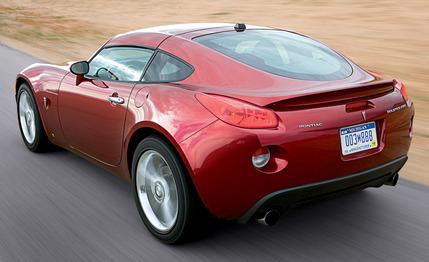
 Short Take Road Test
Short Take Road Test


Pontiac faces a tenuous future as General Motors restructures its many fiefdoms. The automaker has said the brand once known for excitement won’t be dragged out behind the barn anytime soon, so expect Pontiac to atrophy toward a purveyor of niche vehicles outside the core lineups of Chevrolet, Cadillac, Buick, and GMC. The rear-wheel-drive Solstice roadster, which entered service for 2006 and received a shot in the arm the next year in the form of the GXP model and its 260-hp turbocharged 2.0-liter Ecotec four, is a good example of those niche vehicles.
Although we favored Mazda’s delightful MX-5 Miata over the base Solstice in a head-to-head comparison test, American consumers have gobbled up enough of the Pontiacs to make the Solstice the bestselling roadster in the U.S. over the past three full calendar years. Now GM is expanding the range with a coupe variant, which promises to be more practical—and even more handsomely styled—than the roadster.
Say Goodbye to the Sun
Both Solstice coupe and roadster concepts were unveiled at the 2002 Detroit auto show, and Pontiac says the closed-roof model was always part of the product plan. Overall changes between the two body styles are minimal, with both versions sharing the same equipment, powertrains, and body panels, except for the coupe’s sloping rear hatch and new taillights, of course. An aluminum roof bow is the primary structural modification, which also allows for a four-inch-lower load floor and 5.6 cubic feet of cargo space versus the roadster’s 5.4 top-up figure.
Although the new coupe does feature a removable targa roof panel similar to the Corvette’s, the most-noticeable result of putting a lid on the roadster’s already snug confines is a small, dark cabin with terrible sightlines in almost every direction. Forward vision is compromised by GM’s bulky, OnStar-equipped rearview mirror, and the Solstice’s high beltline and low roof make for cartoonishly small side windows. Things aren’t much better in the rear, as the coupe’s shapely tail results in large blind spots. And the small, high-mounted glass hatch is hard to see out of—especially with anything larger than a backpack onboard—and difficult to load gear into. On the plus side, cargo is more secure than it is in the roadster.
Removing the 31-pound magnesium and plastic roof section, a task one person can manage, makes being in the cabin less depressing—and the car looks good with its lid off. However, the panel is too large to be kept in the car. GM’s parts unit offers a removable softtop assembly, but it takes up precious room in the cargo area, costs $1100, and requires a good deal of effort to assemble and finesse into place. We’d recommend just checking the weather report before setting out. Leaving the targa roof in place also hides the Solstice’s sorely underwhelming interior, complete with hard plastics, ultra-cushy seats with the lateral support of wet cardboard, and limited room for six-footers.
New Duds, Same Character
Base Solstice coupes start at $26,845, and GXP models begin at $30,995, a premium of about $2000 and $1000 over the corresponding roadsters. For 2009, all Solstices come standard with ABS, electronic stability control, Bluetooth connectivity, a limited-slip differential, and revised 18-inch wheels. Nearly every specification for the coupe mirrors that of the convertible, yet compared with the last GXP roadster we evaluated in 2007, our GXP hardtop was 0.4 second quicker to 60 mph at 5.2 seconds, faster through the quarter-mile (13.7 seconds at 102 mph versus 14.2 at 98), and managed 0.87 g around the skidpad against 0.85 g for the open-top car.


Our observed fuel economy of 23 mpg also was better than the roadster’s 18 mpg, yet braking from 70 mph was slightly worse: 176 feet to the roadster’s 170. Both vehicles were fitted with the standard five-speed manual transmission. A five-speed automatic is a $995 option, but the manual better suits the character of the Solstice, even if it could benefit from closer ratios, a more precise shifter, and a sixth gear. The weight difference between the two cars is negligible, with the coupe just 49 pounds heavier according to our scales.
Away from the test track, the coupe adopts the roadster’s soft, highway-friendly suspension tuning, vague steering, and twitchy handling. Replacing the underperforming Goodyear Eagle F1 GS-2 tires with more aggressive rubber likely would boost a driver’s confidence at the limit—as would the optional $1095 Club Sport package and its revised suspension and steering hardware. But we think your money would be better spent on the GM Performance power upgrade, which nets an ECU reflash and a new manifold air-pressure sensor for $650, plus installation. It’s good for 290 hp and 340 lb-ft of torque, gains of 30 hp and 80 lb-ft over the stock GXP. However, Pontiac says the modification must be performed during the delivery of a new car in order to retain the standard five-year/100,000-mile powertrain warranty. Installing the kit afterward knocks the coverage down to one year/12,000 miles or the remainder of the three-year/36,000-mile new-vehicle warranty, whichever is longer.
With its new roof, the Solstice coupe is most attractive—we named it one of the top 10 most beautiful cars for ’09. The styling, though, is probably the biggest reason to choose a Solstice coupe over a Miata equipped with the optional power retractable hardtop. The Miata, after all, is arguably as secure as the Solstice coupe, offers more usable space, and is far more rewarding to drive. Still, the GXP offers a lot more thrust for your dollar than the Mazda, and this new coupe can perhaps provide a bit of a boost to the Solstice’s sales figures, which have nose-dived over the past year. So the Solstice still falls short of sports-car bliss, but we’re interested in seeing how much the optional power upgrade sweetens the deal—somebody get Pontiac on the phone.